Plastic Waste Management Strategies and Their Environmental Aspects: A Scientometric Analysis and Comprehensive Review
Abstract
:1. Introduction
2. Scientometric Analysis Methods
3. Results and Discussions
3.1. Subject Areas and Annual Publication Pattern
3.2. Publication Sources
3.3. Keywords
3.4. Authors
3.5. Documents
3.6. Countries
4. Management Techniques for Plastic Waste
4.1. Landfills
4.2. Recycling
4.3. Pyrolysis
4.4. Liquefaction
4.5. Road Construction and Tar
4.6. Concrete Production
5. Discussion and Environmental Aspects
6. Future Recommendations
- To control landfilling PW, local governments can promote closed-loop recycling of PW through a variety of initiatives and campaigns, as well as by imposing restrictions and fines on landfilling and incineration, while simultaneously lowering taxes on recyclable materials.
- Waste management techniques should be considered when designing plastics, mixes, and mechanical recycling processes. If the continuous use of plastics is required, it is better to understand their material life cycle and develop solutions that can sustain their worth over repeated uses and reprocessing. This uniformity will result in increased recycling rates, increased recycled content in products, and a reduction in the amount of plastic we export, landfill, and burn.
- Several aspects, including the state of the PW, the presence of impurities in the PW, and the type of reactor, influence the mechanism of catalytic pyrolysis and, therefore, the yield and distribution of the products. Thus, the effects of all these variables must be carefully known and regulated to assure the process’s viability. Another problem is developing standards for post-consumer PW processes and products, as well as adopting more complex pyrolysis technologies. Additionally, while it is possible to get a suitable product yield and composition at the laboratory scale, industrial producers will face difficulties maintaining the desired result while scaling up PW pyrolysis. If these obstacles are overcome, it will be possible to accomplish a low-cost, partial replacement of dwindling fossil fuels, as well as a reduction in PW, which is currently the primary source of environmental contamination, and a reduction in crude oil imports.
- Liquefaction of PW is a viable alternative to pyrolysis for resolving the problem of excess PW due to its gentler processing conditions [143]. Although the generation of oil from this process offers an alternative to the transportation industry’s reliance on fossil fuels, additional research is required to properly optimize the approach and determine the oil’s efficiency in engines.
- The use of PW in construction materials will reduce not only dependency on natural resources but also material costs. However, using PW as an aggregate in large quantities in construction materials is not recommended due to a significant loss of material strength. In general, a replacement ratio of 10–15% of PW may yield material with adequate mechanical properties [132,133,134,135]. The increased air content and lower bonding capacity of PW in concrete are the primary causes of decreased strength. Further research is required in this domain to optimize these aspects. By modifying the shape, size, and surface of PW particles, the material properties can be considerably improved. Additionally, guidelines for the use of PW in construction materials are crucial for reliable design and construction since they describe the appropriate content, allowable size and shape, and structural types. Indeed, standards are often formed over a period of several years after collecting sufficient, reliable information and an understanding of the subject has been achieved. As a result, it is advised that further research be conducted on the long-term performance of PW in construction materials, as well as tits impact on the environment and service life.
7. Conclusions
- (1)
- The analysis of publication sources containing documents on the research of PW management revealed that the leading 3 sources are Waste Management; Resources, Conservation and Recycling; and Science of the Total Environment with 548, 270, and 227 papers, respectively. Moreover, the aforementioned journals also received the most citations in the related research area with 25,171, 13,142, and 11,555 citations, respectively.
- (2)
- The evaluation of keywords in the subject research area disclosed that the top five most frequently occurring keyword combinations on the subject topic included “waste management”, “plastic, recycling”, “plastics”, and “plastic waste”. It was noticed that PW recycling has been under study mostly for waste management and sustainable development.
- (3)
- The analysis of authors showed that only 60 authors had published at least 10 articles on PW management. The top authors, with respect to the number of articles, citations, and average citations, were categorized. In terms of total publications, the top 3 writers are Li, J. with 39; Wang, H. with 36; and Zhang, Y. with 34 publications. Thompson, R.C. leads the field in terms of citations with 7055; Wilcox, C. is second with 5130; and Li, J. is third with 1964 citations up through 2021. Additionally, when comparing average citations, the following writers stand out: Thompson, R.C. has about 588; Wilcox, C. has about 395; and Al-Salem, S.M. has about 140 average citations.
- (4)
- The assessment of documents containing data on PW management showed that Jambeck, J.R. [55] obtained 4313 citations for their publication “Plastic waste inputs from land into the ocean”. Geyer, R. [13] and Hidalgo-Ruz, V. [56] received 3675 and 2007 citations, respectively, for their particular works and were rated in the leading 3. In addition, it was found that only 10 articles received more than 1000 citations on the subject through 2021.
- (5)
- The leading countries, based on their participation in the research of PW management, were analyzed, and we discovered that only 48 countries produced at least 30 articles. The United States, India, and China each presented 871, 581, and 551 papers, respectively. However, the United States had the most citations (42,924), followed by the United Kingdom (30,071), and China (19,944).
- (6)
- According to past studies, PW management strategies are broadly classified into six categories: landfills, recycling, pyrolysis, liquefaction, road construction and tar, and concrete production. Among these, landfilling is the most undesirable strategy as it causes environmental and human health concerns. On the other hand, recycling has equal merits and demerits; pyrolysis and liquefaction have more significant by-products, such as fuel and char, but they demand high energy. However, the use of PW for road construction and concrete production were found to be the most effective methods.
- (7)
- Recycling PW to produce various products will result in sustainable solutions due to the prevention of the use of natural resources, the minimizing of waste management problems, the reduction of environmental pollution, and the production of eco-friendly materials at a lower cost.
Author Contributions
Funding
Institutional Review Board Statement
Informed Consent Statement
Data Availability Statement
Acknowledgments
Conflicts of Interest
References
- Tang, Z.; Li, W.; Tam, V.W.Y.; Xue, C. Advanced progress in recycling municipal and construction solid wastes for manufacturing sustainable construction materials. Resour. Conserv. Recycl. X 2020, 6, 100036. [Google Scholar] [CrossRef]
- Zhang, K.; Shi, H.; Peng, J.; Wang, Y.; Xiong, X.; Wu, C.; Lam, P.K.S. Microplastic pollution in China’s inland water systems: A review of findings, methods, characteristics, effects, and management. Sci. Total Environ. 2018, 630, 1641–1653. [Google Scholar] [CrossRef] [PubMed]
- Zhao, Y.; Tan, Y.; Feng, S. Does reducing air pollution improve the progress of sustainable development in China? J. Clean. Prod. 2020, 272, 122759. [Google Scholar] [CrossRef]
- Moharir, R.V.; Kumar, S. Challenges associated with plastic waste disposal and allied microbial routes for its effective degradation: A comprehensive review. J. Clean. Prod. 2019, 208, 65–76. [Google Scholar] [CrossRef]
- Chow, C.-F.; So, W.-M.W.; Cheung, T.-Y.; Yeung, S.-K.D. Plastic waste problem and education for plastic waste management. In Emerging Practices in Scholarship of Learning and Teaching in a Digital Era; Springer: Berlin/Heidelberg, Germany, 2017; pp. 125–140. [Google Scholar]
- Idumah, C.I.; Nwuzor, I.C. Novel trends in plastic waste management. SN Appl. Sci. 2019, 1, 1–14. [Google Scholar] [CrossRef] [Green Version]
- Sharuddin, S.D.A.; Abnisa, F.; Daud, W.M.A.W.; Aroua, M.K. A review on pyrolysis of plastic wastes. Energy Convers. Manag. 2016, 115, 308–326. [Google Scholar] [CrossRef]
- Wong, S.L.; Ngadi, N.; Abdullah, T.A.T.; Inuwa, I.M. Current state and future prospects of plastic waste as source of fuel: A review. Renew. Sustain. Energy Rev. 2015, 50, 1167–1180. [Google Scholar] [CrossRef]
- Pan, D.; Su, F.; Liu, C.; Guo, Z. Research progress for plastic waste management and manufacture of value-added products. Adv. Compos. Hybrid Mater. 2020, 3, 443–461. [Google Scholar] [CrossRef]
- Bai, B.; Jin, H.; Fan, C.; Cao, C.; Wei, W.; Cao, W. Experimental investigation on liquefaction of plastic waste to oil in supercritical water. Waste Manag. 2019, 89, 247–253. [Google Scholar] [CrossRef]
- Gibb, B.C. Plastics are forever. Nat. Chem. 2019, 11, 394–395. [Google Scholar] [CrossRef]
- Facts, P. An Analysis of European Plastics Production, Demand and Waste Data; Techical Report; Plastic Europe: 2019. Available online: https://plasticseurope.org/wp-content/uploads/2021/10/2019-Plastics-the-facts.pdf (accessed on 20 October 2021).
- Geyer, R.; Jambeck, J.R.; Law, K.L. Production, use, and fate of all plastics ever made. Sci. Adv. 2017, 3, e1700782. [Google Scholar] [CrossRef] [PubMed] [Green Version]
- Rodrigues, M.O.; Abrantes, N.; Gonçalves, F.J.M.; Nogueira, H.; Marques, J.C.; Gonçalves, A.M.M. Impacts of plastic products used in daily life on the environment and human health: What is known? Environ. Toxicol. Pharmacol. 2019, 72, 103239. [Google Scholar] [CrossRef] [PubMed]
- Colantonio, S.; Cafiero, L.; De Angelis, D.; Ippolito, N.M.; Tuffi, R.; Ciprioti, S.V. Thermal and catalytic pyrolysis of a synthetic mixture representative of packaging plastics residue. Front. Chem. Sci. Eng. 2020, 14, 288–303. [Google Scholar] [CrossRef]
- Garcia, J.M.; Robertson, M.L. The future of plastics recycling. Science 2017, 358, 870–872. [Google Scholar] [CrossRef] [PubMed]
- Da Cruz, N.F.; Simões, P.; Marques, R.C. Costs and benefits of packaging waste recycling systems. Resour. Conserv. Recycl. 2014, 85, 1–4. [Google Scholar] [CrossRef] [Green Version]
- Gu, F.; Guo, J.; Zhang, W.; Summers, P.A.; Hall, P. From waste plastics to industrial raw materials: A life cycle assessment of mechanical plastic recycling practice based on a real-world case study. Sci. Total Environ. 2017, 601, 1192–1207. [Google Scholar] [CrossRef] [PubMed]
- Vollmer, I.; Jenks, M.J.F.; Roelands, M.C.P.; White, R.J.; van Harmelen, T.; de Wild, P.; van Der Laan, G.P.; Meirer, F.; Keurentjes, J.T.F.; Weckhuysen, B.M. Beyond mechanical recycling: Giving new life to plastic waste. Angew. Chem. Int. Ed. 2020, 59, 15402–15423. [Google Scholar] [CrossRef] [PubMed] [Green Version]
- Psomopoulos, C.S.; Bourka, A.; Themelis, N.J. Waste-to-energy: A review of the status and benefits in USA. Waste Manag. 2009, 29, 1718–1724. [Google Scholar] [CrossRef]
- Ashworth, D.C.; Elliott, P.; Toledano, M.B. Waste incineration and adverse birth and neonatal outcomes: A systematic review. Environ. Int. 2014, 69, 120–132. [Google Scholar] [CrossRef]
- Franchini, M.; Rial, M.; Buiatti, E.; Bianchi, F. Health effects of exposure to waste incinerator emissions: A review of epidemiological studies. Ann. Dell’istituto Super. Sanità 2004, 40, 101–115. [Google Scholar]
- Yang, N.; Zhang, H.; Chen, M.; Shao, L.-M.; He, P.-J. Greenhouse gas emissions from MSW incineration in China: Impacts of waste characteristics and energy recovery. Waste Manag. 2012, 32, 2552–2560. [Google Scholar] [CrossRef] [PubMed]
- Pramila, R.; Ramesh, K.V. Biodegradation of low density polyethylene (LDPE) by fungi isolated from municipal landfill area. J. Microbiol. Biotechnol. Res 2011, 1, e136. [Google Scholar]
- Alyousef, R.; Ahmad, W.; Ahmad, A.; Aslam, F.; Joyklad, P.; Alabduljabbar, H. Potential use of recycled plastic and rubber aggregate in cementitious materials for sustainable construction: A review. J. Clean. Prod. 2021, 329, 129736. [Google Scholar] [CrossRef]
- Teuten, E.L.; Saquing, J.M.; Knappe, D.R.U.; Barlaz, M.A.; Jonsson, S.; Björn, A.; Rowland, S.J.; Thompson, R.C.; Galloway, T.S.; Yamashita, R. Transport and release of chemicals from plastics to the environment and to wildlife. Philos. Trans. R. Soc. B: Biol. Sci. 2009, 364, 2027–2045. [Google Scholar] [CrossRef] [PubMed] [Green Version]
- Okan, M.; Aydin, H.M.; Barsbay, M. Current approaches to waste polymer utilization and minimization: A review. J. Chem. Technol. Biotechnol. 2019, 94, 8–21. [Google Scholar] [CrossRef] [Green Version]
- Zhang, F.; Zhao, Y.; Wang, D.; Yan, M.; Zhang, J.; Zhang, P.; Ding, T.; Chen, L.; Chen, C. Current technologies for plastic waste treatment: A review. J. Clean. Prod. 2021, 282, 124523. [Google Scholar] [CrossRef]
- Rokdey, S.N.; Naktode, P.L.; Nikhar, M.R. Use of plastic waste in road construction. Int. J. Comput. Appl. 2015, 7, 27–29. [Google Scholar]
- Da Silva, T.R.; Cecchin, D.; de Azevedo, A.R.G.; Valadão, I.; Alexandre, J.; da Silva, F.C.; Marvila, M.T.; Gunasekaran, M.; Garcia Filho, F.; Monteiro, S.N. Technological Characterization of PET—Polyethylene Terephthalate—Added Soil-Cement Bricks. Materials 2021, 14, 5035. [Google Scholar] [CrossRef]
- Da Silva, T.R.; de Azevedo, A.R.G.; Cecchin, D.; Marvila, M.T.; Amran, M.; Fediuk, R.; Vatin, N.; Karelina, M.; Klyuev, S.; Szelag, M. Application of plastic wastes in construction materials: A review using the concept of life-cycle assessment in the context of recent research for future perspectives. Materials 2021, 14, 3549. [Google Scholar] [CrossRef]
- Kazemi, M.; Kabir, S.F.; Fini, E.H. State of the art in recycling waste thermoplastics and thermosets and their applications in construction. Resour. Conserv. Recycl. 2021, 174, 105776. [Google Scholar] [CrossRef]
- Xu, Y.; Zeng, J.; Chen, W.; Jin, R.; Li, B.; Pan, Z. A holistic review of cement composites reinforced with graphene oxide. Constr. Build. Mater. 2018, 171, 291–302. [Google Scholar] [CrossRef]
- Xiao, X.; Skitmore, M.; Li, H.; Xia, B. Mapping knowledge in the economic areas of green building using scientometric analysis. Energies 2019, 12, 3011. [Google Scholar] [CrossRef] [Green Version]
- Darko, A.; Chan, A.P.; Huo, X.; Owusu-Manu, D.-G. A scientometric analysis and visualization of global green building research. Build. Environ. 2019, 149, 501–511. [Google Scholar] [CrossRef]
- Ahmad, W.; Ahmad, A.; Ostrowski, K.A.; Aslam, F.; Joyklad, P. A scientometric review of waste material utilization in concrete for sustainable construction. Case Stud. Constr. Mater. 2021, 15, e00683. [Google Scholar] [CrossRef]
- Ahmad, W.; Ahmad, A.; Ostrowski, K.A.; Aslam, F.; Joyklad, P.; Zajdel, P. Sustainable approach of using sugarcane bagasse ash in cement-based composites: A systematic review. Case Stud. Constr. Mater. 2021, 15, e00698. [Google Scholar] [CrossRef]
- Aghaei Chadegani, A.; Salehi, H.; Yunus, M.; Farhadi, H.; Fooladi, M.; Farhadi, M.; Ale Ebrahim, N. A comparison between two main academic literature collections: Web of Science and Scopus databases. Asian Soc. Sci. 2013, 9, 18–26. [Google Scholar] [CrossRef] [Green Version]
- Afgan, S.; Bing, C. Scientometric review of international research trends on thermal energy storage cement based composites via integration of phase change materials from 1993 to 2020. Constr. Build. Mater. 2021, 278, 122344. [Google Scholar] [CrossRef]
- Bergman, E.M.L. Finding citations to social work literature: The relative benefits of using Web of Science, Scopus, or Google Scholar. J. Acad. Librariansh. 2012, 38, 370–379. [Google Scholar] [CrossRef] [Green Version]
- Meho, L.I. Using Scopus’s CiteScore for assessing the quality of computer science conferences. J. Informetr. 2019, 13, 419–433. [Google Scholar] [CrossRef]
- Zuo, J.; Zhao, Z.-Y. Green building research–current status and future agenda: A review. Renew. Sustain. Energy Rev. 2014, 30, 271–281. [Google Scholar] [CrossRef]
- Darko, A.; Zhang, C.; Chan, A.P. Drivers for green building: A review of empirical studies. Habitat Int. 2017, 60, 34–49. [Google Scholar] [CrossRef]
- Ahmad, W.; Khan, M.; Smarzewski, P. Effect of Short Fiber Reinforcements on Fracture Performance of Cement-Based Materials: A Systematic Review Approach. Materials 2021, 14, 1745. [Google Scholar] [CrossRef] [PubMed]
- Li, X.; Qin, D.; Hu, Y.; Ahmad, W.; Ahmad, A.; Aslam, F.; Joyklad, P. A systematic review of waste materials in cement-based composites for construction applications. J. Build. Eng. 2021, 45, 103447. [Google Scholar] [CrossRef]
- Markoulli, M.P.; Lee, C.I.; Byington, E.; Felps, W.A. Mapping Human Resource Management: Reviewing the field and charting future directions. Hum. Resour. Manag. Rev. 2017, 27, 367–396. [Google Scholar] [CrossRef]
- Goulden, S.; Erell, E.; Garb, Y.; Pearlmutter, D. Green building standards as socio-technical actors in municipal environmental policy. Build. Res. Inf. 2017, 45, 414–425. [Google Scholar] [CrossRef]
- Jin, R.; Gao, S.; Cheshmehzangi, A.; Aboagye-Nimo, E. A holistic review of off-site construction literature published between 2008 and 2018. J. Clean. Prod. 2018, 202, 1202–1219. [Google Scholar] [CrossRef] [Green Version]
- Park, J.Y.; Nagy, Z. Comprehensive analysis of the relationship between thermal comfort and building control research-A data-driven literature review. Renew. Sustain. Energy Rev. 2018, 82, 2664–2679. [Google Scholar] [CrossRef]
- Oraee, M.; Hosseini, M.R.; Papadonikolaki, E.; Palliyaguru, R.; Arashpour, M. Collaboration in BIM-based construction networks: A bibliometric-qualitative literature review. Int. J. Proj. Manag. 2017, 35, 1288–1301. [Google Scholar] [CrossRef]
- Van Eck, N.J.; Waltman, L. Software survey: VOSviewer, a computer program for bibliometric mapping. Scientometrics 2010, 84, 523–538. [Google Scholar] [CrossRef] [Green Version]
- Wuni, I.Y.; Shen, G.Q.; Osei-Kyei, R. Scientometric review of global research trends on green buildings in construction journals from 1992 to 2018. Energy Build. 2019, 190, 69–85. [Google Scholar] [CrossRef]
- Su, H.-N.; Lee, P.-C. Mapping knowledge structure by keyword co-occurrence: A first look at journal papers in Technology Foresight. Scientometrics 2010, 85, 65–79. [Google Scholar] [CrossRef]
- Yu, F.; Hayes, B.E. Applying data analytics and visualization to assessing the research impact of the Cancer Cell Biology (CCB) Program at the University of North Carolina at Chapel Hill. J. E Sci. Librariansh. 2018, 7, 4. [Google Scholar] [CrossRef]
- Jambeck, J.R.; Geyer, R.; Wilcox, C.; Siegler, T.R.; Perryman, M.; Andrady, A.; Narayan, R.; Law, K.L. Plastic waste inputs from land into the ocean. Science 2015, 347, 768–771. [Google Scholar] [CrossRef] [PubMed]
- Hidalgo-Ruz, V.; Gutow, L.; Thompson, R.C.; Thiel, M. Microplastics in the marine environment: A review of the methods used for identification and quantification. Environ. Sci. Technol. 2012, 46, 3060–3075. [Google Scholar] [CrossRef] [PubMed]
- Thompson, R.C.; Moore, C.J.; Vom Saal, F.S.; Swan, S.H. Plastics, the environment and human health: Current consensus and future trends. Philos. Trans. R. Soc. B: Biol. Sci. 2009, 364, 2153–2166. [Google Scholar] [CrossRef] [PubMed]
- Al-Salem, S.M.; Lettieri, P.; Baeyens, J. Recycling and recovery routes of plastic solid waste (PSW): A review. Waste Manag. 2009, 29, 2625–2643. [Google Scholar] [CrossRef] [PubMed]
- Lebreton, L.; Van Der Zwet, J.; Damsteeg, J.-W.; Slat, B.; Andrady, A.; Reisser, J. River plastic emissions to the world’s oceans. Nat. Commun. 2017, 8, 1–10. [Google Scholar] [CrossRef] [PubMed]
- Hopewell, J.; Dvorak, R.; Kosior, E. Plastics recycling: Challenges and opportunities. Philos. Trans. R. Soc. B Biol. Sci. 2009, 364, 2115–2126. [Google Scholar] [CrossRef] [Green Version]
- Eerkes-Medrano, D.; Thompson, R.C.; Aldridge, D.C. Microplastics in freshwater systems: A review of the emerging threats, identification of knowledge gaps and prioritisation of research needs. Water Res. 2015, 75, 63–82. [Google Scholar] [CrossRef]
- Horton, A.A.; Walton, A.; Spurgeon, D.J.; Lahive, E.; Svendsen, C. Microplastics in freshwater and terrestrial environments: Evaluating the current understanding to identify the knowledge gaps and future research priorities. Sci. Total Environ. 2017, 586, 127–141. [Google Scholar] [CrossRef] [Green Version]
- Gopinath, K.P.; Nagarajan, V.M.; Krishnan, A.; Malolan, R. A critical review on the influence of energy, environmental and economic factors on various processes used to handle and recycle plastic wastes: Development of a comprehensive index. J. Clean. Prod. 2020, 274, 123031. [Google Scholar] [CrossRef]
- Lazarevic, D.; Aoustin, E.; Buclet, N.; Brandt, N. Plastic waste management in the context of a European recycling society: Comparing results and uncertainties in a life cycle perspective. Resour. Conserv. Recycl. 2010, 55, 246–259. [Google Scholar] [CrossRef]
- Tabata, T.; Hishinuma, T.; Ihara, T.; Genchi, Y. Life cycle assessment of integrated municipal solid waste management systems, taking account of climate change and landfill shortage trade-off problems. Waste Manag. Res. 2011, 29, 423–432. [Google Scholar] [CrossRef] [PubMed]
- Idris, A.; Inanc, B.; Hassan, M.N. Overview of waste disposal and landfills/dumps in Asian countries. J. Mater. Cycles Waste Manag. 2004, 6, 104–110. [Google Scholar] [CrossRef]
- Alabi, O.A.; Ologbonjaye, K.I.; Awosolu, O.; Alalade, O.E. Public and environmental health effects of plastic wastes disposal: A review. J. Toxicol. Risk Assess. 2019, 5, 1–13. [Google Scholar]
- Rajmohan, K.V.S.; Ramya, C.; Viswanathan, M.R.; Varjani, S. Plastic pollutants: Effective waste management for pollution control and abatement. Curr. Opin. Environ. Sci. Health 2019, 12, 72–84. [Google Scholar] [CrossRef]
- Li, X.; Ling, T.-C.; Mo, K.H. Functions and impacts of plastic/rubber wastes as eco-friendly aggregate in concrete–A review. Constr. Build. Mater. 2020, 240, 117869. [Google Scholar] [CrossRef]
- Siddique, R.; Khatib, J.; Kaur, I. Use of recycled plastic in concrete: A review. Waste Manag. 2008, 28, 1835–1852. [Google Scholar] [CrossRef]
- Briassoulis, D.; Hiskakis, M.; Babou, E. Technical specifications for mechanical recycling of agricultural plastic waste. Waste Manag. 2013, 33, 1516–1530. [Google Scholar] [CrossRef]
- Ragaert, K.; Delva, L.; Van Geem, K. Mechanical and chemical recycling of solid plastic waste. Waste Manag. 2017, 69, 24–58. [Google Scholar] [CrossRef]
- Soto, J.M.; Blázquez, G.; Calero, M.; Quesada, L.; Godoy, V.; Martín-Lara, M.Á. A real case study of mechanical recycling as an alternative for managing of polyethylene plastic film presented in mixed municipal solid waste. J. Clean. Prod. 2018, 203, 777–787. [Google Scholar] [CrossRef]
- Subramanian, P.M. Plastics recycling and waste management in the US. Resour. Conserv. Recycl. 2000, 28, 253–263. [Google Scholar] [CrossRef]
- Aryan, Y.; Yadav, P.; Samadder, S.R. Life Cycle Assessment of the existing and proposed plastic waste management options in India: A case study. J. Clean. Prod. 2019, 211, 1268–1283. [Google Scholar] [CrossRef]
- Klyosov, A.A. Wood-plastic Composites; John Wiley & Sons: Hoboken, NJ, USA, 2007. [Google Scholar]
- Cholake, S.T.; Rajarao, R.; Henderson, P.; Rajagopal, R.R.; Sahajwalla, V. Composite panels obtained from automotive waste plastics and agricultural macadamia shell waste. J. Clean. Prod. 2017, 151, 163–171. [Google Scholar] [CrossRef]
- Ge, Z.H.; Si, D.G.; Lan, Y.L.; Shi, M.N. The effect of modifying agents on the mechanical properties of straw flour/waste plastic composite materials. Key Eng. Mat. 2017, 723, 56–61. [Google Scholar] [CrossRef]
- Miandad, R.; Barakat, M.A.; Aburiazaiza, A.S.; Rehan, M.; Nizami, A.S. Catalytic pyrolysis of plastic waste: A review. Process. Saf. Environ. Prot. 2016, 102, 822–838. [Google Scholar] [CrossRef]
- Panda, A.K.; Singh, R.K.; Mishra, D.K. Thermolysis of waste plastics to liquid fuel: A suitable method for plastic waste management and manufacture of value added products—A world prospective. Renew. Sustain. Energy Rev. 2010, 14, 233–248. [Google Scholar] [CrossRef]
- Sharma, B.K.; Moser, B.R.; Vermillion, K.E.; Doll, K.M.; Rajagopalan, N. Production, characterization and fuel properties of alternative diesel fuel from pyrolysis of waste plastic grocery bags. Fuel Process. Technol. 2014, 122, 79–90. [Google Scholar] [CrossRef]
- Miandad, R.; Barakat, M.A.; Aburiazaiza, A.S.; Rehan, M.; Ismail, I.M.I.; Nizami, A.S. Effect of plastic waste types on pyrolysis liquid oil. Int. Biodeterior. Biodegrad. 2017, 119, 239–252. [Google Scholar] [CrossRef]
- Jung, S.-H.; Cho, M.-H.; Kang, B.-S.; Kim, J.-S. Pyrolysis of a fraction of waste polypropylene and polyethylene for the recovery of BTX aromatics using a fluidized bed reactor. Fuel Processing Technol. 2010, 91, 277–284. [Google Scholar] [CrossRef]
- Onwudili, J.A.; Insura, N.; Williams, P.T. Composition of products from the pyrolysis of polyethylene and polystyrene in a closed batch reactor: Effects of temperature and residence time. J. Anal. Appl. Pyrolysis 2009, 86, 293–303. [Google Scholar] [CrossRef]
- Fakhr Hoseini, S.M.; Dastanian, M. Predicting pyrolysis products of PE, PP, and PET using NRTL activity coefficient model. J. Chem. 2013, 2013, 5. [Google Scholar] [CrossRef]
- Chin, B.L.F.; Yusup, S.; Al Shoaibi, A.; Kannan, P.; Srinivasakannan, C.; Sulaiman, S.A. Kinetic studies of co-pyrolysis of rubber seed shell with high density polyethylene. Energy Convers. Manag. 2014, 87, 746–753. [Google Scholar] [CrossRef]
- Al-Salem, S.M.; Antelava, A.; Constantinou, A.; Manos, G.; Dutta, A. A review on thermal and catalytic pyrolysis of plastic solid waste (PSW). J. Environ. Manag. 2017, 197, 177–198. [Google Scholar] [CrossRef] [PubMed]
- Mastral, F.J.; Esperanza, E.; Garcıa, P.; Juste, M. Pyrolysis of high-density polyethylene in a fluidised bed reactor. Influence of the temperature and residence time. J. Anal. Appl. Pyrolysis 2002, 63, 1–15. [Google Scholar] [CrossRef]
- Singh, R.K.; Ruj, B. Time and temperature depended fuel gas generation from pyrolysis of real world municipal plastic waste. Fuel 2016, 174, 164–171. [Google Scholar] [CrossRef]
- Jin, Q.; Wang, X.; Li, S.; Mikulčić, H.; Bešenić, T.; Deng, S.; Vujanović, M.; Tan, H.; Kumfer, B.M. Synergistic effects during co-pyrolysis of biomass and plastic: Gas, tar, soot, char products and thermogravimetric study. J. Energy Inst. 2019, 92, 108–117. [Google Scholar] [CrossRef]
- Undri, A.; Rosi, L.; Frediani, M.; Frediani, P. Efficient disposal of waste polyolefins through microwave assisted pyrolysis. Fuel 2014, 116, 662–671. [Google Scholar] [CrossRef]
- Prawisudha, P.; Namioka, T.; Yoshikawa, K. Coal alternative fuel production from municipal solid wastes employing hydrothermal treatment. Appl. Energy 2012, 90, 298–304. [Google Scholar] [CrossRef]
- Yang, C.; Li, R.; Cui, C.; Liu, S.; Qiu, Q.; Ding, Y.; Wu, Y.; Zhang, B. Catalytic hydroprocessing of microalgae-derived biofuels: A review. Green Chem. 2016, 18, 3684–3699. [Google Scholar] [CrossRef]
- Xu, D.; Lin, G.; Guo, S.; Wang, S.; Guo, Y.; Jing, Z. Catalytic hydrothermal liquefaction of algae and upgrading of biocrude: A critical review. Renew. Sustain. Energy Rev. 2018, 97, 103–118. [Google Scholar] [CrossRef]
- Cai, J.; He, Y.; Yu, X.; Banks, S.W.; Yang, Y.; Zhang, X.; Yu, Y.; Liu, R.; Bridgwater, A.V. Review of physicochemical properties and analytical characterization of lignocellulosic biomass. Renew. Sustain. Energy Rev. 2017, 76, 309–322. [Google Scholar] [CrossRef] [Green Version]
- Sugano, M.; Komatsu, A.; Yamamoto, M.; Kumagai, M.; Shimizu, T.; Hirano, K.; Mashimo, K. Liquefaction process for a hydrothermally treated waste mixture containing plastics. J. Mat. Cycl. Waste Manag. 2009, 11, 27–31. [Google Scholar] [CrossRef]
- Zhang, X.; Lei, H.; Zhu, L.; Zhu, X.; Qian, M.; Yadavalli, G.; Wu, J.; Chen, S. Thermal behavior and kinetic study for catalytic co-pyrolysis of biomass with plastics. Bioresour. Technol. 2016, 220, 233–238. [Google Scholar] [CrossRef] [PubMed]
- Hongthong, S.; Raikova, S.; Leese, H.S.; Chuck, C.J. Co-processing of common plastics with pistachio hulls via hydrothermal liquefaction. Waste Manag. 2020, 102, 351–361. [Google Scholar] [CrossRef]
- Arena, U.; Zaccariello, L.; Mastellone, M.L. Tar removal during the fluidized bed gasification of plastic waste. Waste Manag. 2009, 29, 783–791. [Google Scholar] [CrossRef]
- Mastellone, M.L.; Arena, U. Olivine as a tar removal catalyst during fluidized bed gasification of plastic waste. AIChE J. 2008, 54, 1656–1667. [Google Scholar] [CrossRef]
- Kurt, Y.; Isik, K. Comparison of tar produced by traditional and laboratory methods. Stud. Ethno-Med. 2012, 6, 77–83. [Google Scholar] [CrossRef]
- Limantara, A.D.; Gardjito, E.; Ridwan, A.; Subiyanto, B.; Raharjo, D.; Santoso, A.; Heryanto, B.; Sudarmanto, H.L. Comparative Study of Bio-Asphalt, Coconut Shell Distillation Tar, and Plastic Road in terms of Construction, Economical, and Regulatory Aspects. J. Phys. Conf. Ser 2019, 1364, 012058. [Google Scholar] [CrossRef]
- Siham, K.; Fabrice, B.; Edine, A.N.; Patrick, D. Marine dredged sediments as new materials resource for road construction. Waste Manag. 2008, 28, 919–928. [Google Scholar] [CrossRef]
- Chavan, M.A.J. Use of plastic waste in flexible pavements. Int. J. Appl. Innov. Eng. Manag. 2013, 2, 540–552. [Google Scholar]
- Caputo, P.; Porto, M.; Loise, V.; Teltayev, B.; Rossi, C.O. Analysis of mechanical performance of bitumen modified with waste plastic and rubber additives by rheology and self diffusion NMR experiments. Eurasian Chem.-Technol. J. 2019, 21, 235–239. [Google Scholar] [CrossRef]
- Manju, R.; Sathya, S.; Sheema, K. Use of plastic waste in bituminous pavement. Int J. ChemTech Res. 2017, 10, 804–811. [Google Scholar]
- Vasudevan, R.; Sekar, A.R.C.; Sundarakannan, B.; Velkennedy, R. A technique to dispose waste plastics in an ecofriendly way–Application in construction of flexible pavements. Constr. Build. Mater. 2012, 28, 311–320. [Google Scholar] [CrossRef]
- Bondre, R.A.; Kamble, P.S.; Chauhan, S.L. Use of Plastic Waste Material in Flexible Pavements. Int. J. Emerg. Technol. 2015, 6, 172. [Google Scholar]
- Jafar, J.J. Utilisation of waste plastic in bituminous mix for improved performance of roads. KSCE J. Civ. Eng. 2016, 20, 243–249. [Google Scholar] [CrossRef]
- Behl, A.; Sharma, G.; Kumar, G. A sustainable approach: Utilization of waste PVC in asphalting of roads. Constr. Build. Mater. 2014, 54, 113–117. [Google Scholar] [CrossRef]
- Ahmad, W.; Farooq, S.H.; Usman, M.; Khan, M.; Ahmad, A.; Aslam, F.; Yousef, R.A.; Abduljabbar, H.A.; Sufian, M. Effect of coconut fiber length and content on properties of high strength concrete. Materials 2020, 13, 1075. [Google Scholar] [CrossRef] [Green Version]
- Khan, M.; Ali, M. Improvement in concrete behavior with fly ash, silica-fume and coconut fibres. Constr. Build. Mater. 2019, 203, 174–187. [Google Scholar] [CrossRef]
- Khan, M.; Rehman, A.; Ali, M. Efficiency of silica-fume content in plain and natural fiber reinforced concrete for concrete road. Constr. Build. Mater. 2020, 244, 118382. [Google Scholar] [CrossRef]
- Khan, M.; Ali, M. Use of glass and nylon fibers in concrete for controlling early age micro cracking in bridge decks. Constr. Build. Mater. 2016, 125, 800–808. [Google Scholar] [CrossRef]
- Khan, M.; Ali, M. Effectiveness of hair and wave polypropylene fibers for concrete roads. Constr. Build. Mater. 2018, 166, 581–591. [Google Scholar] [CrossRef]
- Khan, M.; Cao, M.; Ai, H.; Hussain, A. Basalt Fibers in Modified Whisker Reinforced Cementitious Composites. Period. Polytech. Civ. Eng. 2022, 66. [Google Scholar] [CrossRef]
- Khan, M.; Cao, M.; Xie, C.; Ali, M. Effectiveness of hybrid steel-basalt fiber reinforced concrete under compression. Case Stud. Constr. Mater. 2022, 16, e00941. [Google Scholar] [CrossRef]
- Saikia, N.; De Brito, J. Use of plastic waste as aggregate in cement mortar and concrete preparation: A review. Constr. Build. Mater. 2012, 34, 385–401. [Google Scholar] [CrossRef]
- Ismail, Z.Z.; Al-Hashmi, E.A. Use of waste plastic in concrete mixture as aggregate replacement. Waste Manag. 2008, 28, 2041–2047. [Google Scholar] [CrossRef] [PubMed]
- Mohammed, A.A.; Mohammed, I.I.; Mohammed, S.A. Some properties of concrete with plastic aggregate derived from shredded PVC sheets. Constr. Build. Mater. 2019, 201, 232–245. [Google Scholar] [CrossRef]
- Manjunath, B.T.A. Partial replacement of E-plastic waste as coarse-aggregate in concrete. Procedia Environ. Sci. 2016, 35, 731–739. [Google Scholar] [CrossRef]
- Basha, S.I.; Ali, M.R.; Al-Dulaijan, S.U.; Maslehuddin, M. Mechanical and thermal properties of lightweight recycled plastic aggregate concrete. J. Build. Eng. 2020, 32, 101710. [Google Scholar] [CrossRef]
- Alaloul, W.S.; John, V.O.; Musarat, M.A. Mechanical and thermal properties of interlocking bricks utilizing wasted polyethylene terephthalate. Int. J. Concr. Struct. Mater. 2020, 14, 1–11. [Google Scholar] [CrossRef]
- Liguori, B.; Iucolano, F.; Capasso, I.; Lavorgna, M.; Verdolotti, L. The effect of recycled plastic aggregate on chemico-physical and functional properties of composite mortars. Mater. Des. 2014, 57, 578–584. [Google Scholar] [CrossRef]
- Babafemi, A.J.; Šavija, B.; Paul, S.C.; Anggraini, V. Engineering Properties of Concrete with Waste Recycled Plastic: A Review. Sustainability 2018, 10, 3875. [Google Scholar] [CrossRef] [Green Version]
- Gu, L.; Ozbakkaloglu, T. Use of recycled plastics in concrete: A critical review. Waste Manag. 2016, 51, 19–42. [Google Scholar] [CrossRef] [PubMed]
- Yesilata, B.; Isıker, Y.; Turgut, P. Thermal insulation enhancement in concretes by adding waste PET and rubber pieces. Constr. Build. Mater. 2009, 23, 1878–1882. [Google Scholar] [CrossRef]
- Rahman, M.M.; Islam, M.A.; Ahmed, M.; Salam, M.A. Recycled polymer materials as aggregates for concrete and blocks. J. Chem. Eng. 2012, 27, 53–57. [Google Scholar] [CrossRef]
- Rahmani, E.; Dehestani, M.; Beygi, M.; Allahyari, H.; Nikbin, I. On the mechanical properties of concrete containing waste PET particles. Constr. Build. Mater. 2013, 47, 1302–1308. [Google Scholar] [CrossRef]
- Murugan, D.; Varughese, S.; Swaminathan, T. Recycled polyolefin-based plastic wastes for sound absorption. Polym.-Plast. Technol. Eng. 2006, 45, 885–888. [Google Scholar] [CrossRef]
- Wang, R.; Meyer, C. Performance of cement mortar made with recycled high impact polystyrene. Cem. Concr. Compos. 2012, 34, 975–981. [Google Scholar] [CrossRef]
- Kaur, G.; Pavia, S. Physical properties and microstructure of plastic aggregate mortars made with acrylonitrile-butadiene-styrene (ABS), polycarbonate (PC), polyoxymethylene (POM) and ABS/PC blend waste. J. Build. Eng. 2020, 31, 101341. [Google Scholar] [CrossRef]
- Ferreira, L.; de Brito, J.; Saikia, N. Influence of curing conditions on the mechanical performance of concrete containing recycled plastic aggregate. Constr. Build. Mater. 2012, 36, 196–204. [Google Scholar] [CrossRef]
- Yang, S.; Yue, X.; Liu, X.; Tong, Y. Properties of self-compacting lightweight concrete containing recycled plastic particles. Constr. Build. Mater. 2015, 84, 444–453. [Google Scholar] [CrossRef]
- Saikia, N.; de Brito, J. Mechanical properties and abrasion behaviour of concrete containing shredded PET bottle waste as a partial substitution of natural aggregate. Constr. Build. Mater. 2014, 52, 236–244. [Google Scholar] [CrossRef]
- Safinia, S.; Alkalbani, A. Use of recycled plastic water bottles in concrete blocks. Procedia Eng. 2016, 164, 214–221. [Google Scholar] [CrossRef]
- Mokhtar, M.; Sahat, S.; Hamid, B.; Kaamin, M.; Kesot, M.J.; Wen, L.C.; Xin, L.Y.; Ling, N.P.; Lei, V.S.J. Application of plastic bottle as a wall structure for green house. ARPN J. Eng. Appl. Sci 2016, 11, 7617–7621. [Google Scholar]
- Sharma, R.; Bansal, P.P. Use of different forms of waste plastic in concrete–a review. J. Clean. Prod. 2016, 112, 473–482. [Google Scholar] [CrossRef]
- Steyn, Z.C.; Babafemi, A.J.; Fataar, H.; Combrinck, R. Concrete containing waste recycled glass, plastic and rubber as sand replacement. Constr. Build. Mater. 2021, 269, 121242. [Google Scholar] [CrossRef]
- Chen, Y.-C. Evaluating greenhouse gas emissions and energy recovery from municipal and industrial solid waste using waste-to-energy technology. J. Clean. Prod. 2018, 192, 262–269. [Google Scholar] [CrossRef]
- Al-Maaded, M.; Madi, N.K.; Kahraman, R.; Hodzic, A.; Ozerkan, N.G. An overview of solid waste management and plastic recycling in Qatar. J. Polym. Environ. 2012, 20, 186–194. [Google Scholar] [CrossRef]
- Awoyera, P.O.; Adesina, A. Plastic wastes to construction products: Status, limitations and future perspective. Case Stud. Constr. Mater. 2020, 12, e00330. [Google Scholar] [CrossRef]
- Ahamed Kameel, N.I.; Wan Daud, W.M.A.; Abdul Patah, M.F.; Mohd Zulkifli, N.W. Influence of reaction parameters on thermal liquefaction of plastic wastes into oil: A review. Energy Convers. Manag. X 2022, 14, 100196. [Google Scholar] [CrossRef]
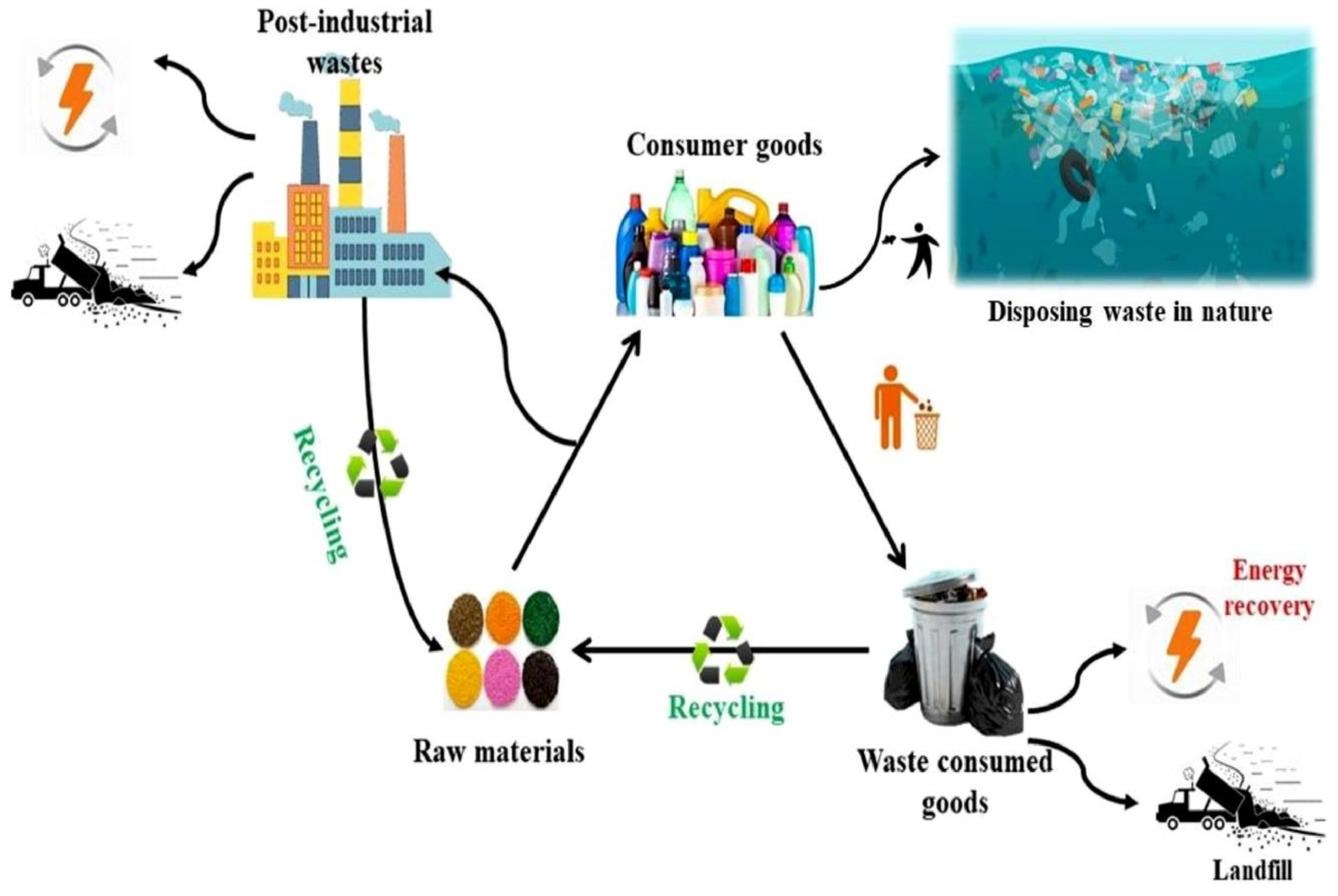
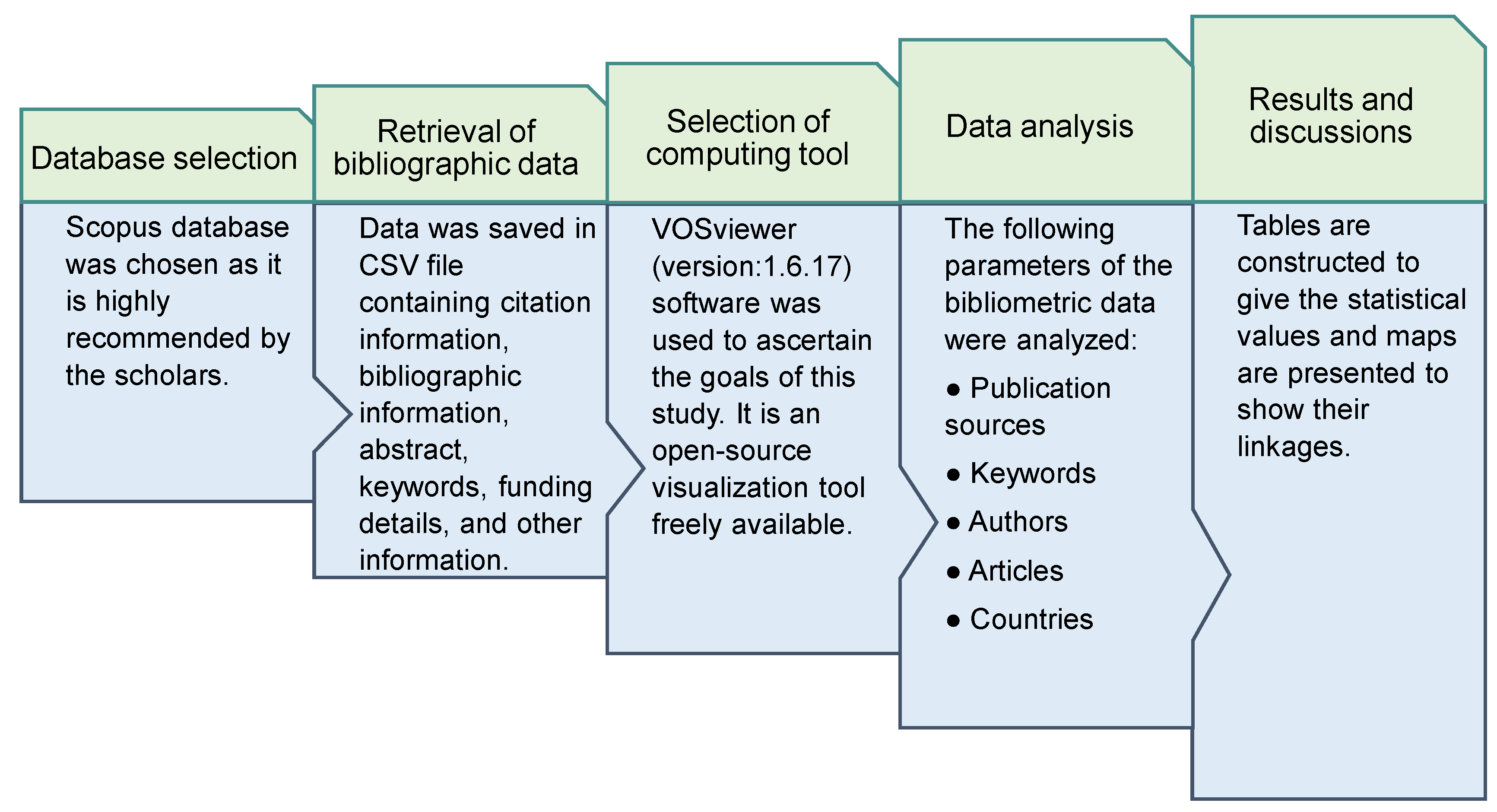
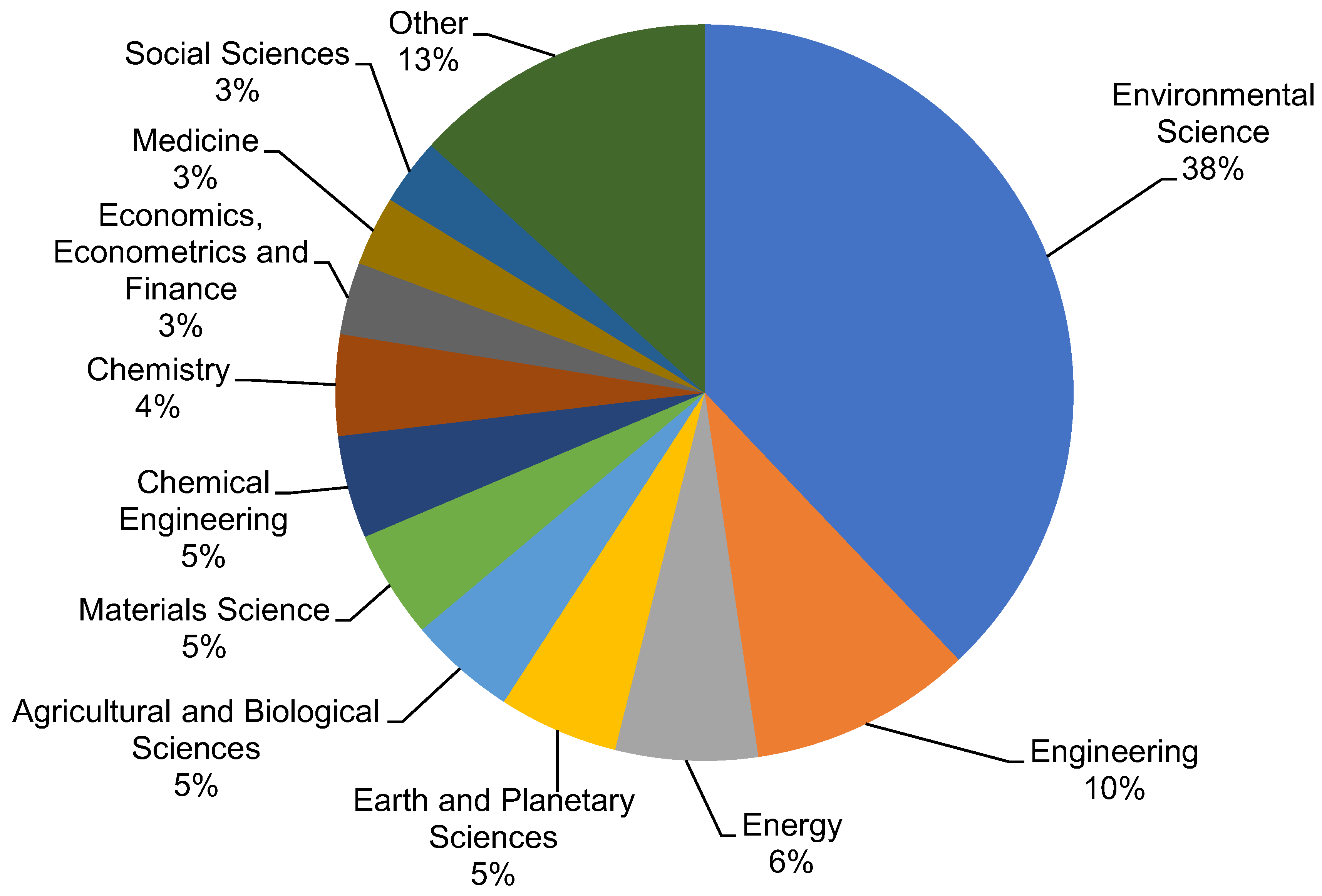

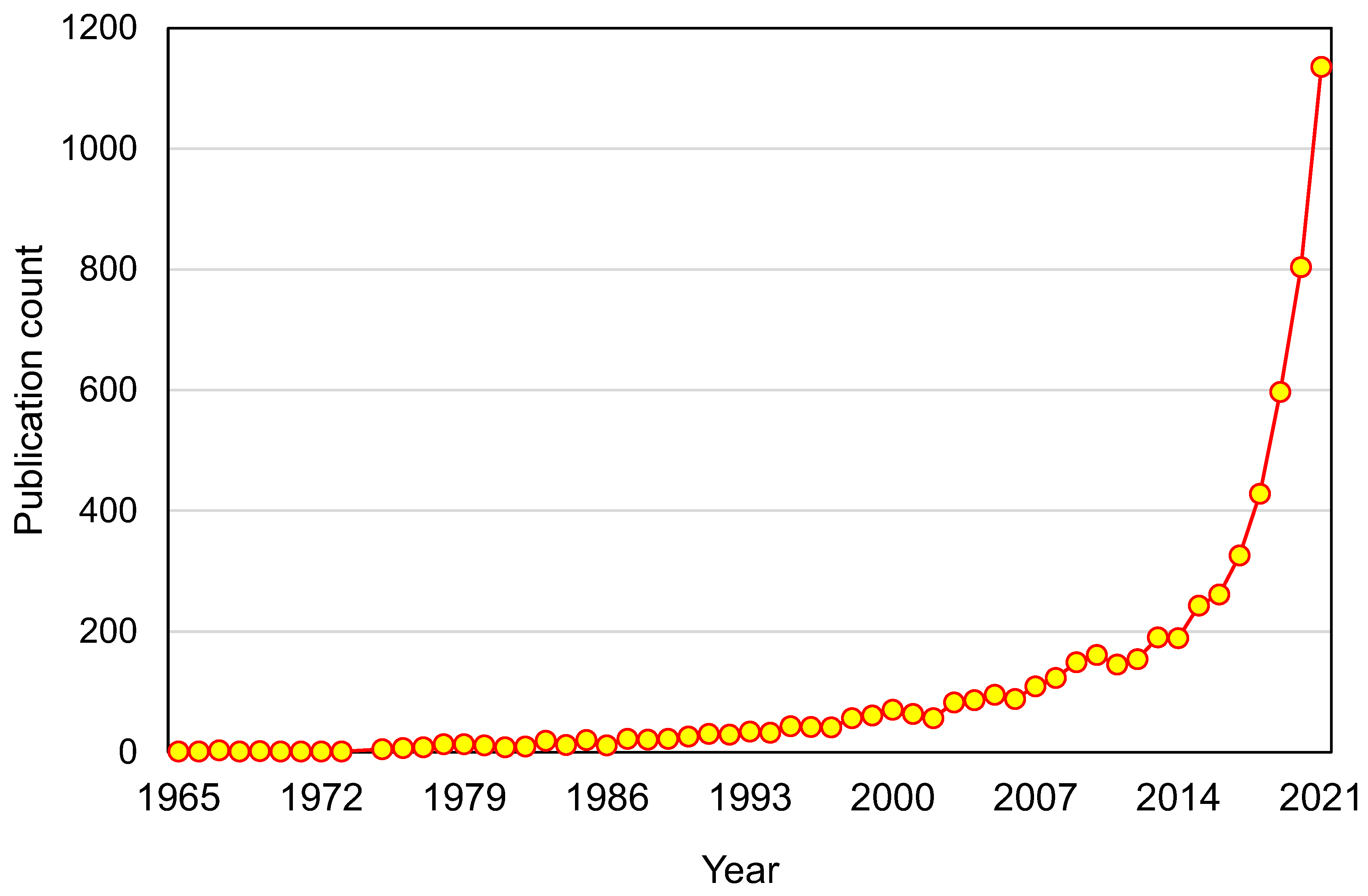
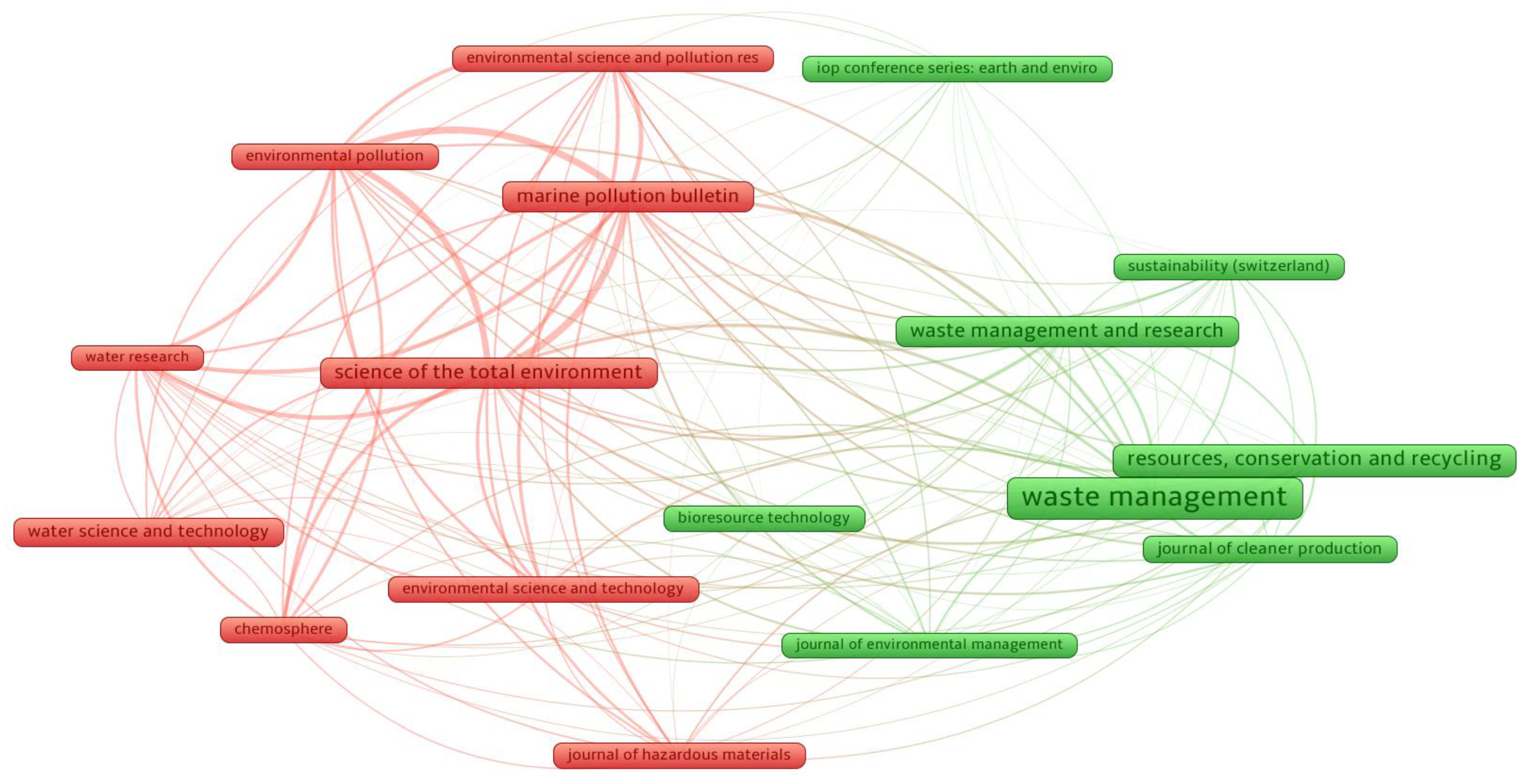
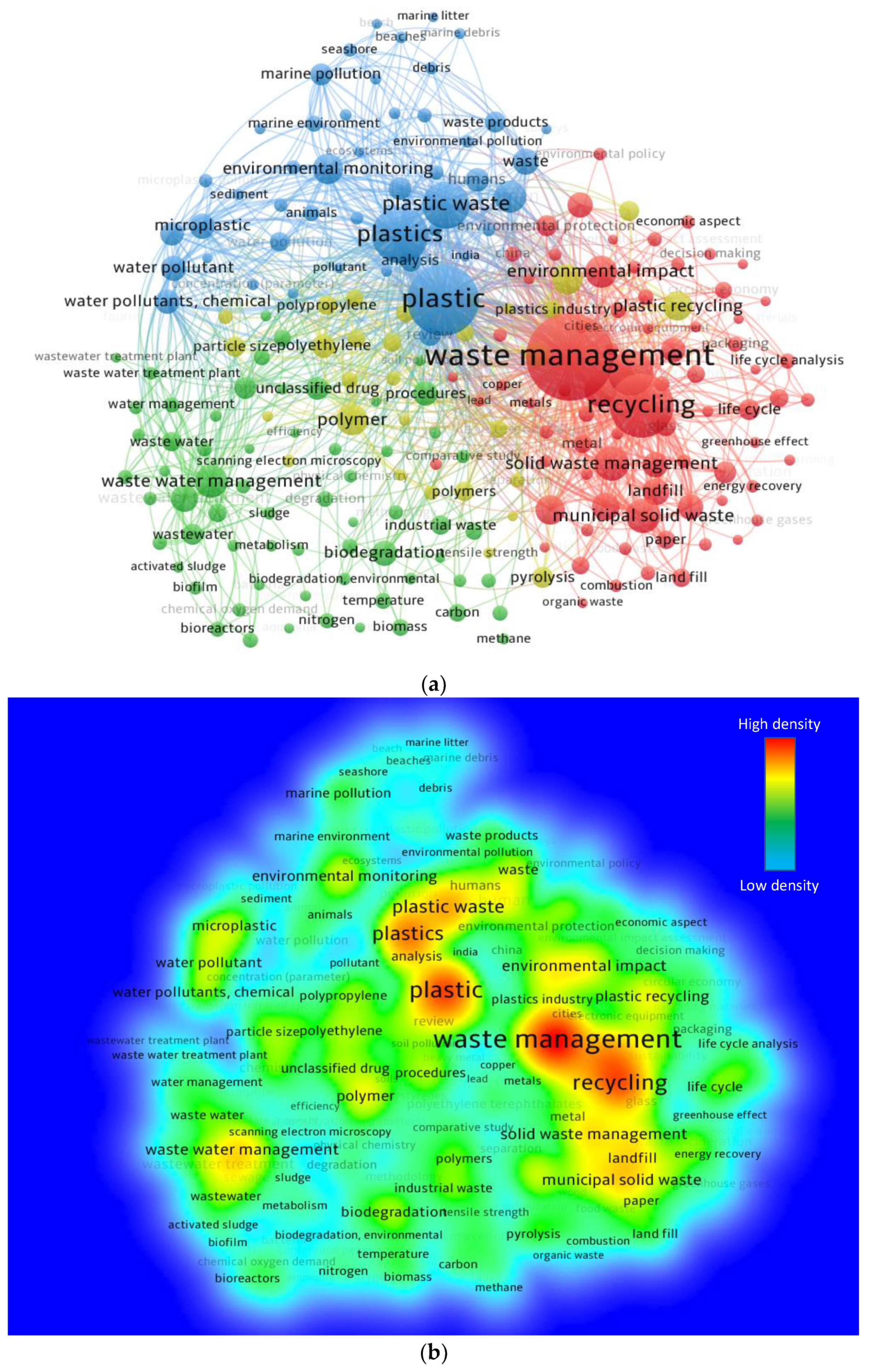

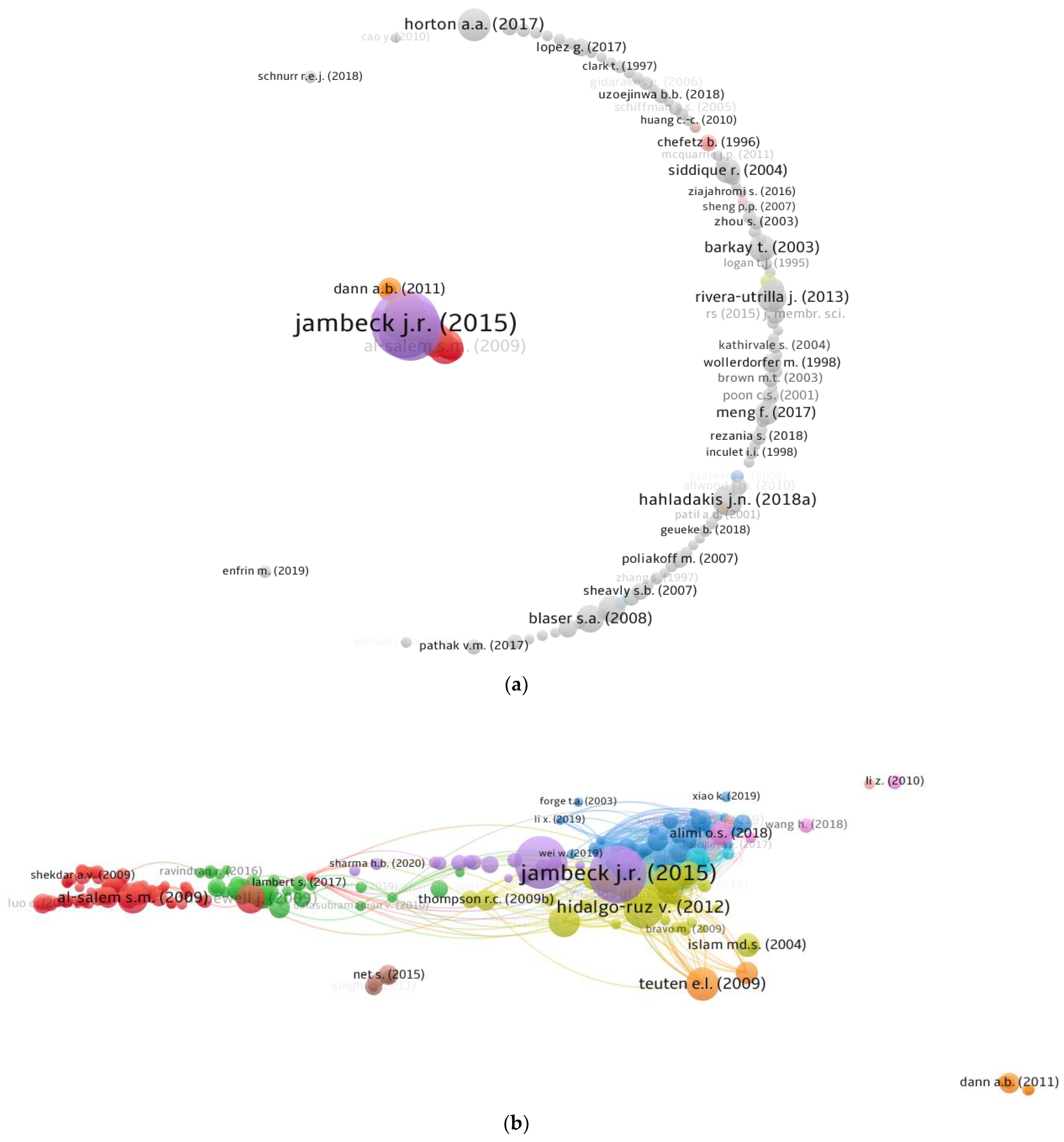

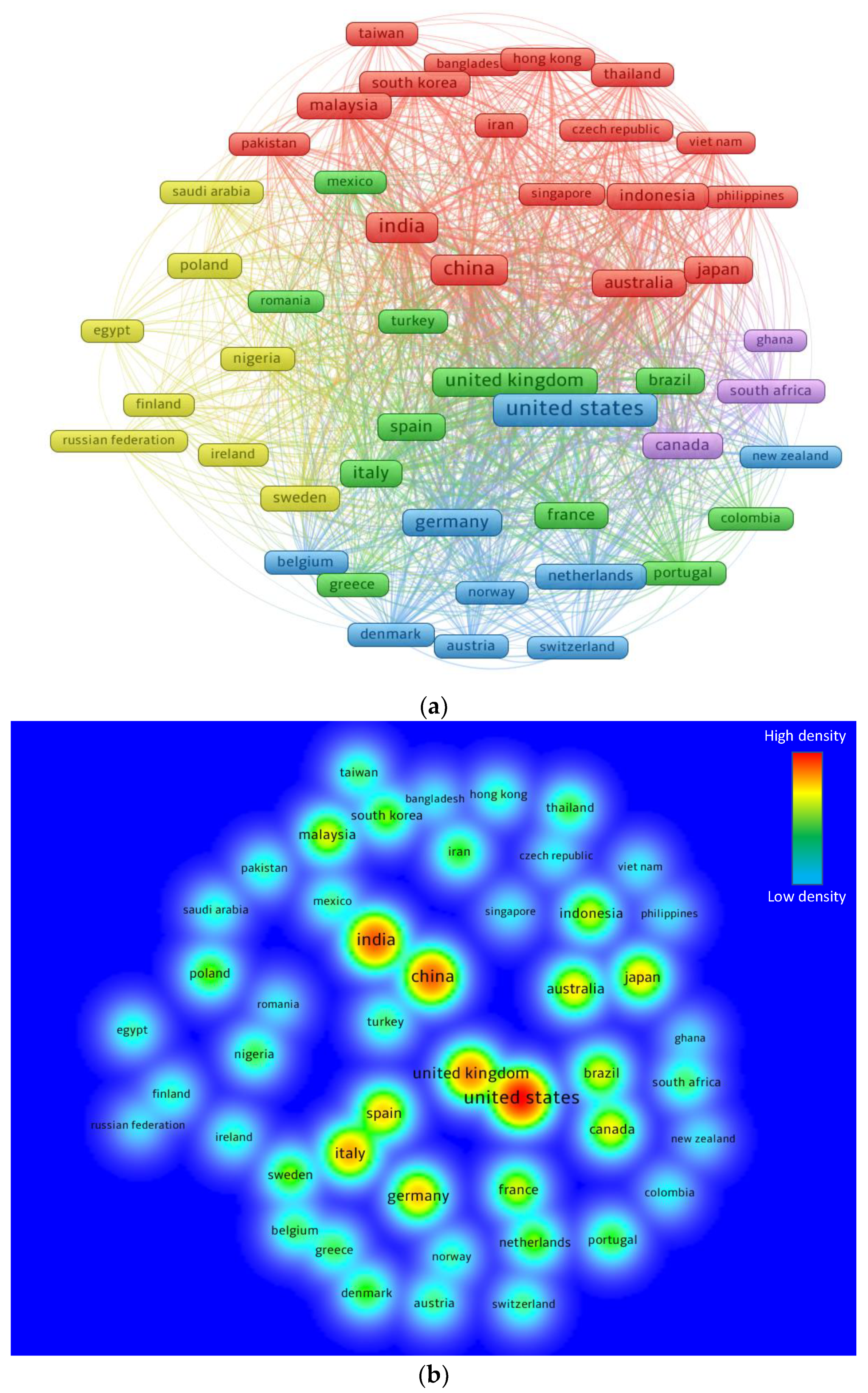
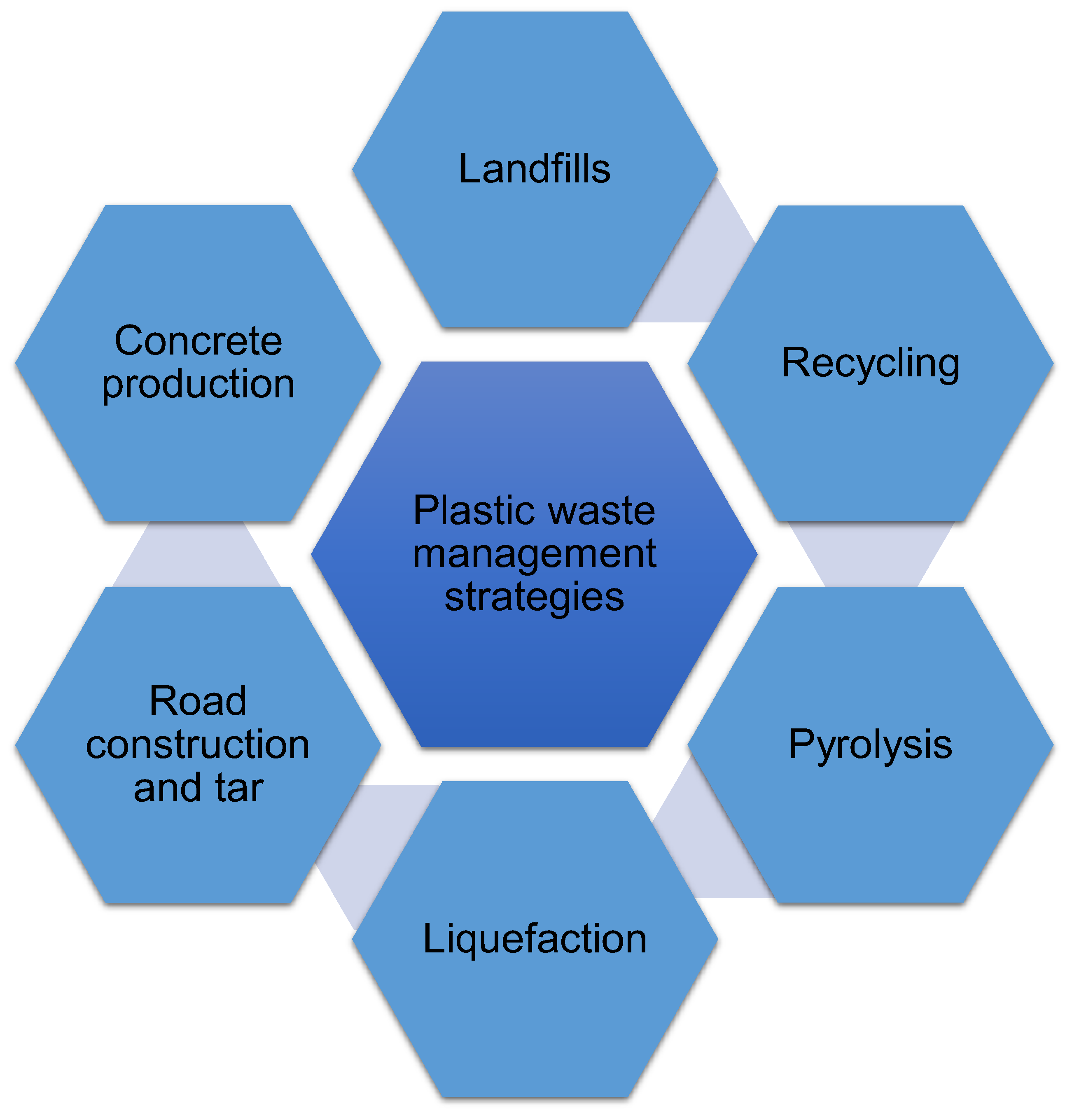
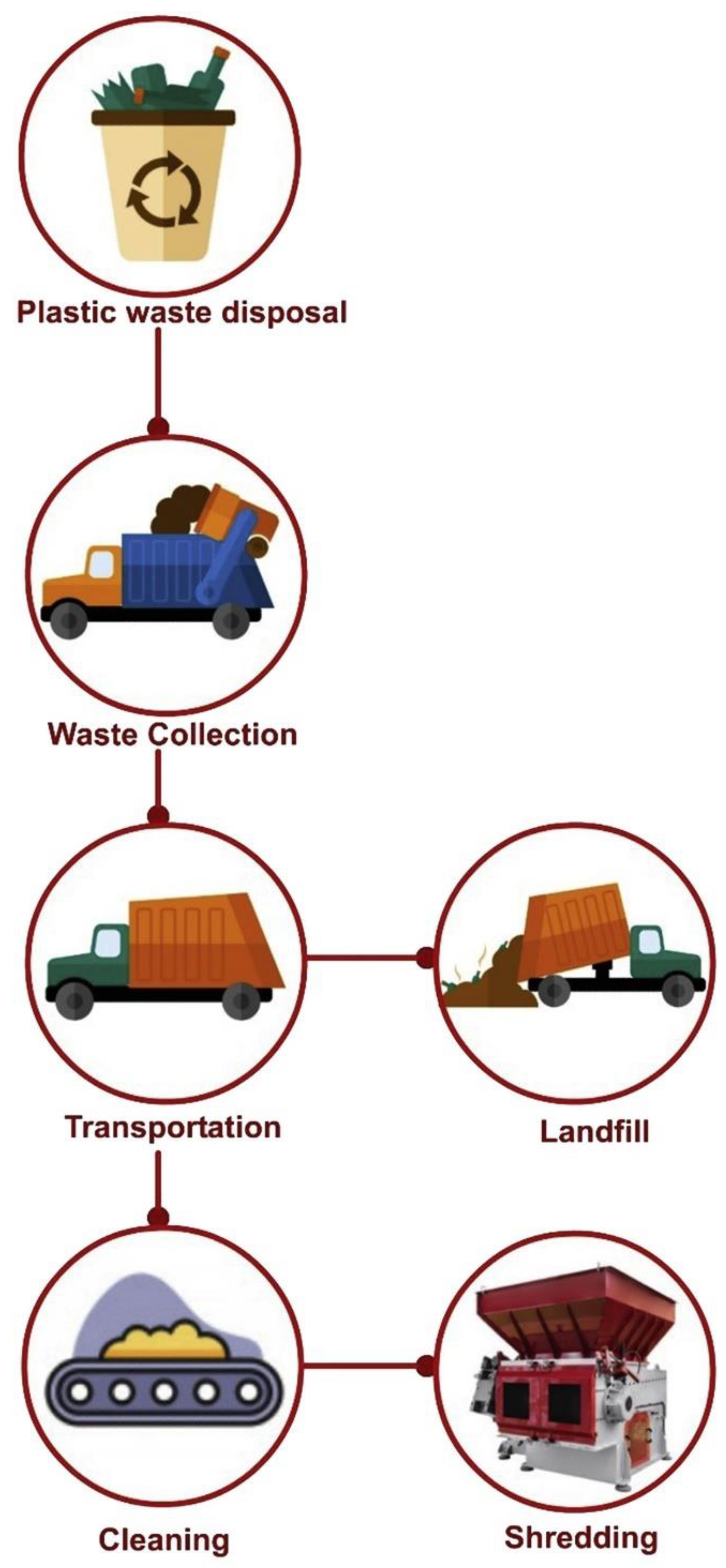

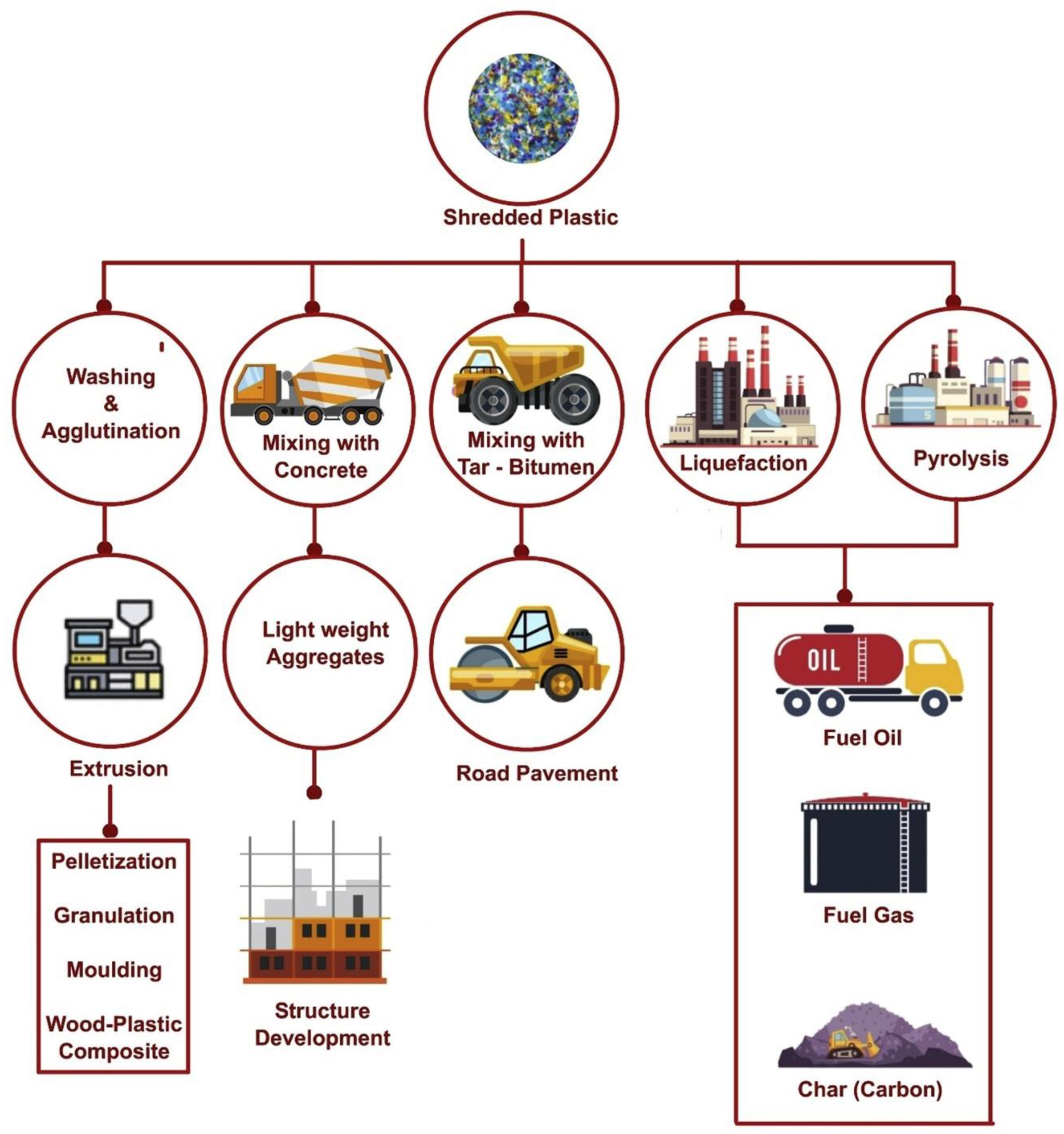

| S/N | Source | Documents | Total Citations |
|---|---|---|---|
| 1 | Waste Management | 548 | 25,171 |
| 2 | Resources, Conservation and Recycling | 270 | 13,142 |
| 3 | Science of the Total Environment | 227 | 11,555 |
| 4 | Waste Management and Research | 221 | 4349 |
| 5 | Marine Pollution Bulletin | 213 | 7516 |
| 6 | Water Science and Technology | 136 | 3163 |
| 7 | Journal of Cleaner Production | 125 | 5024 |
| 8 | Environmental Pollution | 93 | 5108 |
| 9 | Journal of Hazardous Materials | 89 | 5470 |
| 10 | Chemosphere | 88 | 4762 |
| 11 | Environmental Science and Technology | 82 | 9656 |
| 12 | Bioresource Technology | 82 | 4222 |
| 13 | Environmental Science and Pollution Research | 78 | 1917 |
| 14 | IOP Conference Series: Earth and Environmental Science | 75 | 74 |
| 15 | Sustainability (Switzerland) | 74 | 698 |
| 16 | Journal of Environmental Management | 72 | 3106 |
| 17 | Water Research | 71 | 8495 |
| S/N | Keyword | Occurrences |
|---|---|---|
| 1 | Waste management | 3159 |
| 2 | Plastic | 2290 |
| 3 | Recycling | 1925 |
| 4 | Plastics | 1548 |
| 5 | Plastic waste | 1160 |
| 6 | Waste disposal | 1122 |
| 7 | Solid waste management | 709 |
| 8 | Municipal solid waste | 702 |
| 9 | Wastewater management | 656 |
| 10 | Solid waste | 636 |
| 11 | Environmental impact | 628 |
| 12 | Polymer | 618 |
| 13 | Elastomers | 572 |
| 14 | Environmental monitoring | 567 |
| 15 | Plastic recycling | 560 |
| 16 | Waste treatment | 548 |
| 17 | Refuse disposal | 509 |
| 18 | Landfill | 484 |
| 19 | Wastewater treatment | 480 |
| 20 | Waste | 465 |
| S/N | Author | Documents | Total Citations | Average Citations |
|---|---|---|---|---|
| 1 | Li, J. | 39 | 1964 | 50 |
| 2 | Wang, H. | 36 | 1153 | 32 |
| 3 | Zhang, Y. | 34 | 854 | 25 |
| 4 | Wang, J. | 30 | 873 | 29 |
| 5 | Li, Y. | 28 | 596 | 21 |
| 6 | Wang, Y. | 27 | 1417 | 52 |
| 7 | Chen, X. | 26 | 951 | 37 |
| 8 | Wang, Z. | 21 | 826 | 39 |
| 9 | Liu, Y. | 21 | 484 | 23 |
| 10 | Li, X. | 20 | 1085 | 54 |
| 11 | Astrup, T.F. | 20 | 610 | 31 |
| 12 | Wang, S. | 19 | 886 | 47 |
| 13 | Wang, X. | 19 | 479 | 25 |
| 14 | Zhang, J. | 18 | 553 | 31 |
| 15 | Lee, J. | 17 | 686 | 40 |
| 16 | Wang, Q. | 16 | 549 | 34 |
| 17 | Walker, T.R. | 15 | 937 | 62 |
| 18 | Liu, X. | 15 | 738 | 49 |
| 19 | Rodgers, M. | 15 | 297 | 20 |
| 20 | Ragaert, K. | 14 | 1124 | 80 |
| 21 | Chen, Y. | 14 | 695 | 50 |
| 22 | Zhang, H. | 14 | 688 | 49 |
| 23 | Wang, C. | 14 | 291 | 21 |
| 24 | Zhang, L. | 14 | 240 | 17 |
| 25 | Wilcox, C. | 13 | 5130 | 395 |
| 26 | Al-Salem, S.M. | 13 | 1817 | 140 |
| 27 | Hardesty, B.D. | 13 | 884 | 68 |
| 28 | Christensen, T.H. | 13 | 802 | 62 |
| 29 | Zhao, J. | 13 | 425 | 33 |
| 30 | Kumar, S. | 13 | 387 | 30 |
| 31 | Kumar, A. | 13 | 308 | 24 |
| 32 | Thompson, R.C. | 12 | 7055 | 588 |
| 33 | Liu, H. | 12 | 1038 | 87 |
| 34 | Yang, J. | 12 | 614 | 51 |
| 35 | Wu, C. | 12 | 610 | 51 |
| 36 | Osibanjo, O. | 12 | 569 | 47 |
| 37 | De Meester, S. | 12 | 456 | 38 |
| 38 | Duan, H. | 12 | 424 | 35 |
| 39 | Arena, U. | 12 | 416 | 35 |
| 40 | Boldrin, A. | 12 | 282 | 24 |
| 41 | Mbohwa, C. | 12 | 121 | 10 |
| 42 | Mastellone, M.L. | 11 | 438 | 40 |
| 43 | Dewulf, J. | 11 | 423 | 38 |
| 44 | Zhang, C. | 11 | 326 | 30 |
| 45 | Liu, W. | 11 | 188 | 17 |
| 46 | Wang, L. | 11 | 185 | 17 |
| 47 | Rangel-Buitrago, N. | 11 | 181 | 16 |
| 48 | Li, M. | 11 | 145 | 13 |
| 49 | Hahladakis, J.N. | 10 | 1236 | 124 |
| 50 | Li, H. | 10 | 599 | 60 |
| 51 | Yang, Y. | 10 | 484 | 48 |
| 52 | Williams, P.T. | 10 | 428 | 43 |
| 53 | Xu, Z. | 10 | 388 | 39 |
| 54 | Zhang, X. | 10 | 349 | 35 |
| 55 | Fellner, J. | 10 | 304 | 30 |
| 56 | Kumar, V. | 10 | 234 | 23 |
| 57 | Rechberger, H. | 10 | 208 | 21 |
| 58 | Li, C. | 10 | 130 | 13 |
| 59 | Singh, S. | 10 | 129 | 13 |
| 60 | Kumar, R. | 10 | 68 | 7 |
| S/N | Document | Title | Total Citations |
|---|---|---|---|
| 1 | Jambeck, J.R. [55] | “Plastic waste inputs from land into the ocean” | 4313 |
| 2 | Geyer, R. [13] | “Production, use, and fate of all plastics ever made” | 3675 |
| 3 | Hidalgo-Ruz, V. [13,56] | “Microplastics in the marine environment: A review of the methods used for identification and quantification” | 2007 |
| 4 | Teuten, E.L. [26] | “Transport and release of chemicals from plastics to the environment and to wildlife” | 1449 |
| 5 | Thompson, R.C. [57] | “Plastics, the environment and human health: Current consensus and future trends” | 1268 |
| 6 | Al-Salem, S.M. [58] | “Recycling and recovery routes of plastic solid waste (PSW): A review” | 1191 |
| 7 | Lebreton, L.C.M. [59] | “River plastic emissions to the world’s oceans” | 1148 |
| 8 | Hopewell, J. [60] | “Plastics recycling: Challenges and opportunities” | 1123 |
| 9 | Eerkes-Medrano, D. [61] | “Microplastics in freshwater systems: A review of the emerging threats, identification of knowledge gaps and prioritisation of research needs” | 1082 |
| 10 | Horton, A.A. [62] | “Microplastics in freshwater and terrestrial environments: Evaluating the current understanding to identify the knowledge gaps and future research priorities” | 1031 |
| S/N | Country | Documents Published | Total Citations |
|---|---|---|---|
| 1 | United States | 871 | 42,924 |
| 2 | India | 581 | 14,368 |
| 3 | China | 551 | 19,944 |
| 4 | United Kingdom | 443 | 30,071 |
| 5 | Italy | 348 | 10,416 |
| 6 | Germany | 289 | 12,161 |
| 7 | Spain | 269 | 9129 |
| 8 | Japan | 244 | 9415 |
| 9 | Australia | 231 | 13,314 |
| 10 | Canada | 208 | 8889 |
| 11 | Brazil | 187 | 5400 |
| 12 | Malaysia | 185 | 6305 |
| 13 | France | 174 | 5884 |
| 14 | Indonesia | 173 | 2547 |
| 15 | Sweden | 131 | 8164 |
| 16 | South Korea | 130 | 4353 |
| 17 | Netherlands | 128 | 8935 |
| 18 | Poland | 126 | 1809 |
| 19 | Denmark | 113 | 4722 |
| 20 | Iran | 110 | 2555 |
| Management Strategy | Aspect | |||||||
|---|---|---|---|---|---|---|---|---|
| Land Requirement | Carbon Emissions | Energy Requirement | Cost | Skilled Labor Requirement | Localization | Sustainability of Product | Impact on Society | |
| Landfills | A substantial area of useful land is converted into dumping sites | High carbon emissions due to incineration of plastic waste at landfill areas | Low energy requirement—only for equipment and transport | Cost-effective | No skilled labors required | Easily constructed and adopted anywhere | Difficult to keep landfills ecologically pleasant for an extended length of time | Pollutes the land and water; may result in the spread of infectious illness |
| Recycling | A small area of land is needed for a recycling plant | Moderate emissions during the conversion process | Moderate energy required for grinding/cutting | Expensive to convert one plastic item to another, and complete quantity is not converted | Skilled labor requirement is low, only required for segregation, cleaning, and sanitation | Easily adopted anywhere on preferred scale | Favorable influence, as plastic items are continuously transformed into other plastic products, but the chemical structure of the plastic remains constant | Prevents hazardous plastic waste from being disposed of by transforming it into other useful materials. |
| Pyrolysis | A small area of land is needed for a pyrolysis reactor | Low levels of carbon emissions since the process is oxygen-independent | High energy required to maintain high temperature and pressure | Highly expensive equipment and reactor as well as process | Very skilled labor required for design and supervision of reactor | Not adopted easily due to high complexity and cost | No significant impact since pyrolysis products are unlikely to remain in their original state for an extended period | Produces highly valuable products such as liquid and gaseous fuels, as well as char, which enables the problem of overdependence on current fossil fuel stocks to be resolved. |
| Liquefaction | A small area of land is needed for a hydrothermal reactor | Low levels of carbon emissions due to the absence of oxygen in the products | High energy required for efficient thermal degradation | Highly expensive equipment and water consumption | Very skilled labor required for design and supervision of reactor | Not adopted easily due to high complexity and cost | No significant impact since liquefaction products are unlikely to remain in their original state for an extended period | Produces liquid fuels and charcoal, both of which are extremely important and are employed in the generation of energy. |
| Road construction and tar | A small area of land is needed for a mixing plant | Low levels of carbon emissions during plastic and tar mixing | Low energy required for mixing | Low cost for mixing plastic and tar | Very low requirement | Might be adopted on a small scale for private roads | Favorable impact since roads built with plastic waste used in the manufacturing of tar remain for an extended length of time without deterioration | Increases the availability of raw materials for tar production and gives economic benefits |
| Concrete production | A small area of land is needed for a mixing plant | Very low levels of carbon emissions during plastic mixing in concrete | Very low energy required for mixing plastic in concrete | Very low cost required for mixing plastic in concrete | Very low requirement | Might be adopted on a small scale for private buildings | Favorable impact since buildings constructed using plastic in the concrete mix have a better service life. | Provides raw materials for building construction, hence preventing the development of home and municipal plastic waste. |
Publisher’s Note: MDPI stays neutral with regard to jurisdictional claims in published maps and institutional affiliations. |
© 2022 by the authors. Licensee MDPI, Basel, Switzerland. This article is an open access article distributed under the terms and conditions of the Creative Commons Attribution (CC BY) license (https://creativecommons.org/licenses/by/4.0/).
Share and Cite
Huang, S.; Wang, H.; Ahmad, W.; Ahmad, A.; Ivanovich Vatin, N.; Mohamed, A.M.; Deifalla, A.F.; Mehmood, I. Plastic Waste Management Strategies and Their Environmental Aspects: A Scientometric Analysis and Comprehensive Review. Int. J. Environ. Res. Public Health 2022, 19, 4556. https://doi.org/10.3390/ijerph19084556
Huang S, Wang H, Ahmad W, Ahmad A, Ivanovich Vatin N, Mohamed AM, Deifalla AF, Mehmood I. Plastic Waste Management Strategies and Their Environmental Aspects: A Scientometric Analysis and Comprehensive Review. International Journal of Environmental Research and Public Health. 2022; 19(8):4556. https://doi.org/10.3390/ijerph19084556
Chicago/Turabian StyleHuang, Saimin, Hongchang Wang, Waqas Ahmad, Ayaz Ahmad, Nikolai Ivanovich Vatin, Abdeliazim Mustafa Mohamed, Ahmed Farouk Deifalla, and Imran Mehmood. 2022. "Plastic Waste Management Strategies and Their Environmental Aspects: A Scientometric Analysis and Comprehensive Review" International Journal of Environmental Research and Public Health 19, no. 8: 4556. https://doi.org/10.3390/ijerph19084556
APA StyleHuang, S., Wang, H., Ahmad, W., Ahmad, A., Ivanovich Vatin, N., Mohamed, A. M., Deifalla, A. F., & Mehmood, I. (2022). Plastic Waste Management Strategies and Their Environmental Aspects: A Scientometric Analysis and Comprehensive Review. International Journal of Environmental Research and Public Health, 19(8), 4556. https://doi.org/10.3390/ijerph19084556








